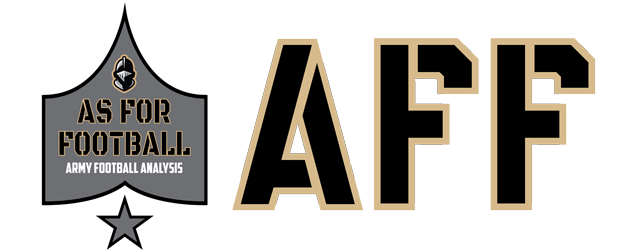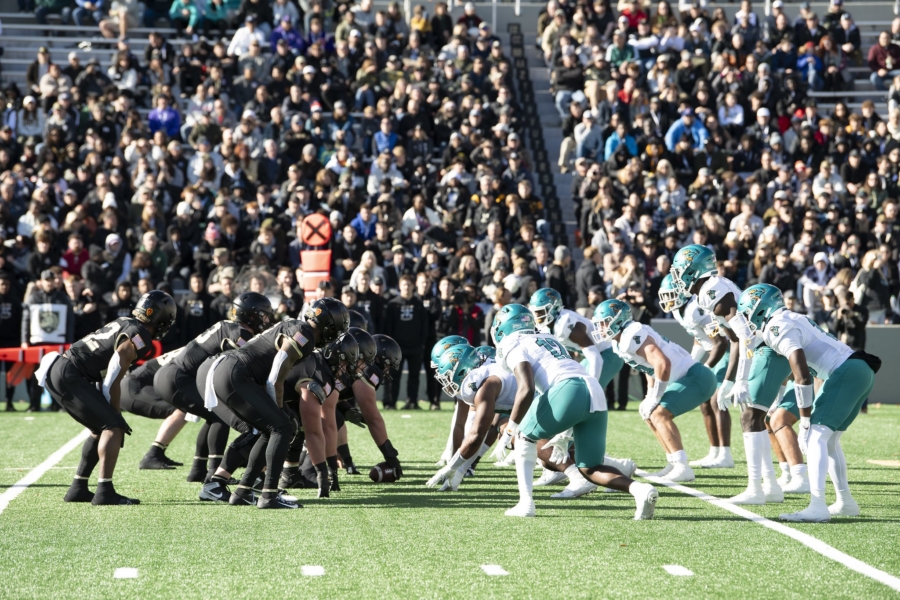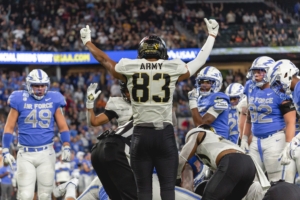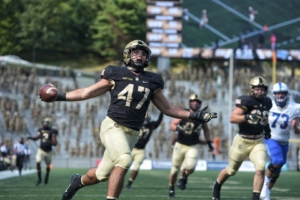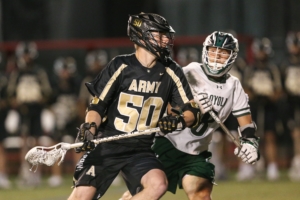Army Football returns to the under center triple-option this year after a year in the Shotgun-Option that did not exactly go as planned. We all saw how successful this new version of the old offense could be in the game against Coastal Carolina at the end of last season, but still it’s worth spending a few moments considering how we got here.
The coaching staff insists that this isn’t just a return to The Way Things Were. We therefore need to understand what happened last year in order to develop some sense of realistic expectations about what we might see in 2024.
Editor’s Note: We were planning to hold this article until early August and run it as part of a series previewing Army’s offense and defense for the coming season. However, there’s so much interest in Army’s offense right now owing to the release of NCAA College Football 25 that we decided to do a post for those who want to play as Army but who don’t necessarily know a lot about the triple-option. But we then realized that a discussion of Tight End use in the triple-is going to seem like it came out of nowhere, so…
You’ll need this post if you want to fully understand the next one. Besides, we’re still developing the NCAA 25 piece with members of our Firstie Club. For better or worse, I am not personally a gamer — at all.
The Shotgun Option
Former Offensive Coordinator Drew Thatcher installed a system that attempted to make three major changes to Army’s previous offense.
1. Zone blocking scheme
2. Crackback blocking scheme with the wide receivers
3. Shotgun snap and meshpoint
Some of this worked, and some of it didn’t.
Zone Blocking Scheme
Friends, this is the part of last year’s scheme that worked.
Coaches Matt Drinkall and Mike Viti developed a new zone blocking scheme for Army’s offensive line, and though there were some undoubted growing pains — especially in the opener against ULM — the team made this work with increasing power and precision as the season progressed. We saw glimpses of what this scheme could accomplish as early as the UTSA game, but the O-Line didn’t reach its full fighting form until Air Force.
From that game forward, Army won four straight.
The new scheme created a few major impacts. First, the O-Line cut down massively on blocking penalties from 2021, mostly by eliminating called chop blocks. Second, Army rediscovered its ability to run up the middle after a 2021 season in which they struggled mightily to run the Fullback Dive. Finally, since O-Linemen kept their feet, they were often able to get down field and continue blocks, leading to lots of extra yardage plays, including RB Kanye Udoh’s massive “rugby scrum” style runs last year against Troy.
This scheme proved so successful that the staff’s offseason reorganization doubled-down on it. Drinkall is now the Offensive Line Coach. Viti is now Assistant Head Coach for Offense / Offensive Line. In terms of recruiting, Army is now expliciting targeting taller, longer offensive linemen to fit this scheme.
All of this is good. More importantly, the team could not have gotten to this point without 2023’s offensive experiments.
Crackback Blocking Scheme With The Wide Receivers
Though this was by far the most interesting part of Thatcher’s scheme, alas, this is the part that did not work. James went into detail on it before the season last summer, but briefly, the idea was to bring a wide receiver off the edge on most snaps to crackback against a linebacker or safety. This would spring an outside runner to the edge against a cornerback one-on-one, allowing for a big gain if that runner could either elude or just run right over that cornerback. Alternatively, the receiver could release across the middle to catch a quick pass and move the chains. There was lots more, but this was the basic idea.
This didn’t work for two reasons. First and foremost, Army couldn’t complete those quick passes, both over the middle and to the sidelines, often enough to reliably move the chains in the second halves of games. The Black Knights usually ran hard in the first half, causing opposing defenses to bring their safeties down into the box. At that point, those quick passes should have opened up, but either pass protection or a simple inability to create completions kept everything from coming together.
The other issue was that Army flat couldn’t get outside from the shotgun often enough against better teams. They just couldn’t find enough team speed or make enough plays in other areas — again, mostly in the passing game — to force the issue and open things up.
What can you do?
We saw this scheme work more-or-less as designed against UTSA and Boston College, but it never became truly reliable, and by midseason, Army had abandoned most of it in favor of straight-up power running between the tackles. Thankfully, that did work. However, that simplified scheme put huge physical pressure on QB Bryson Daily to carry the load, and it also became entirely too predictable.
Shotgun Snap and Meshpoint
By moving the meshpoint back, you give your quarterback more time to make reads in the option, and at least theoretically, you give your O-Line an advantage in pass blocking. As noted, James covered this in detail last year.
BUT.
If you can’t pass reliably, and you’re not really getting to the outside very often, those advantages don’t mean a whole lot. At that point, you may as well go back between the tackles, and run the Hell out of the Midline Option. Indeed, this is exactly what happened last season. However, if that’s the way you’re gonna run the offense, then you might as well come back under center, hit the hole as hard and as fast as you possibly can, and just POUND THE ROCK. And hey, if you pound the rock up the middle often enough, you might also open up those outside running lanes via the triple-option pitch.
This is exactly where the team found itself against Coastal Carolina.
So Wait. This Is All REALLY About the New Blocking Scheme?
Yes. Absolutely. It’s 1000% about the new blocking scheme.
The more Army ran between the tackles last season, the more they started to really specialize in two or even three tight end sets. They’d mostly just mash folks, but they also occasionally released a tight end down the field or out to the flat for a pass, and now, if we look at who they recruited this year, it’s freaking eight tight ends. For a team that’s mostly going to run between the tackles, that ought to give them a truly surprising amount of flexibility in the way they execute this offense.
Moving to a zone blocking scheme allows the fullbacks a little more freedom to choose their holes and read what’s working and what isn’t on any given play. This may or may not be an improvement over the way Army ran the Dive when they cut-blocked, but with the rule changes, it’s become a necessary evolution. Moreover, while we tend to call every play a “Midline Option,” that’s only because it’s often some option variant that starts up the middle. As a matter of reality, there’s a world of football that exists here, and the AFF Crew thinks you’re gonna see a lot more of it in its many of its variations now that the team is running a zone blocking scheme instead of cut-blocking.
The good news is that the Black Knights have the fullbacks to make this work, and they have an experienced option quarterback returning in Daily. We’ve seen what FB Kanye Udoh can do, and based on what we saw from the Spring Game, there are several more guys waiting in the wings who can execute the Fullback Dive. In particular, we’re excited to see FB Jake Rendina hit the field, but he was hardly the only guy who looked good during the Spring Game.
Final Thoughts
This is an exciting time to be an Army Football fan. The offense may not look exactly like it did before, and the execution should change quite a bit in the details. However, this team has everything it needs to be successful on the offensive side of the football, and we’ve already seen on the field that they can make the specific elements of this offense work. We have yet to see exactly how they’ll bring it all together, but whatever else happens, we ought to be in for a fascinating season.

